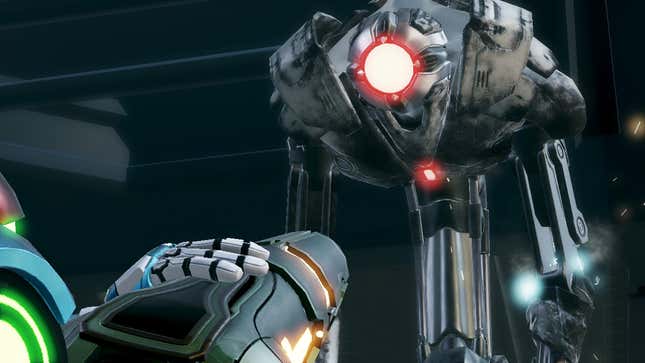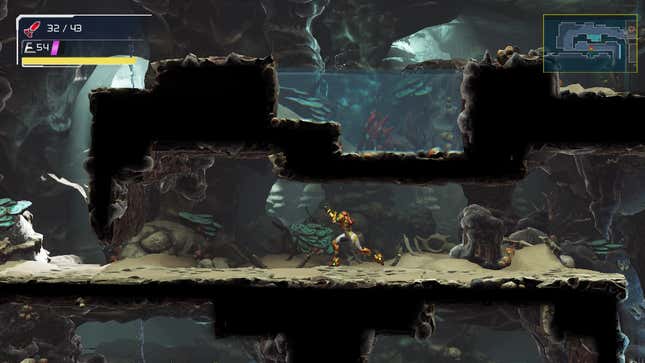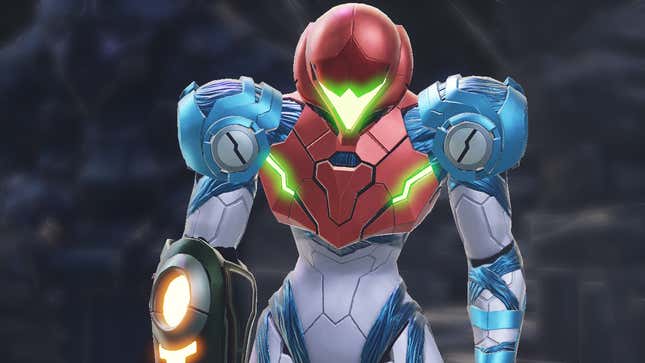Metroid Dread: The Kotaku Review (original) (raw)
I admit I was skeptical. If a game is genuinely going to conjure a sense of dread, as _Metroid Dread_’s title seems to promise, I think it needs to be thorny and aggressive and hostile in ways I wasn’t convinced the Nintendo of 2021 could deliver. Boy, was I wrong to doubt: Metroid Dread is a game with conviction. It is committed to its efforts to put you on edge, to deny you a feeling of sheer domination over your adversaries and your environment, and for that, I applaud it. However, it also lacks the immersive, atmospheric pull of the most beloved Metroid games. The result is a somewhat cold game that possesses a raw technical prowess I intellectually admire, but not the Metroid magic it needed to win over my heart.
As Dread begins the Galactic Federation dispatches intergalactic bounty hunter Samus Aran to the uncharted planet ZDR. The heavily armored E.M.M.I. androids that preceded her have gone silent, but the strange world may hold clues about the virulent X parasite. Samus being immune, she’s the natural choice for such a dangerous mission.
As I wrote after playing about an hour of the game, _Dread_’s beginning is wonderfully destabilizing. You promptly find yourself stranded deep in the cavernous innards of ZDR, stripped of your powers after getting your ass handed to you by a mysterious Chozo warrior. As you communicate with your ship’s computer Adam, your mission is framed less as “Deal with the threat on ZDR like the badass bounty hunter you are” and more “Just stay alive and make it back to your ship so we can get the hell out of here.” It’s a narrative setup that sets the right tone: You don’t have the upper hand here, not by a longshot. In fact, you’re in peril.

This E.M.M.I. has seen better days.
Screenshot: Nintendo / Kotaku
That setup wouldn’t have much weight, though, if the gameplay didn’t back it up. It does, as relentlessly and remorselessly as the E.M.M.I. themselves, which have been transformed by some corrupting force into Terminators who will stop at nothing to capture Samus. Scattered across ZDR, the seven robots each patrol their own zone, and when Samus enters their turf, the tense game of cat and mouse begins. Your weapons are powerless to stop them. They hunt you with speed and agility and cold precision, their movements simultaneously graceful and unsettling. If caught, you have one chance to perform a counter that stuns the robot and enables you to escape, but it’s very tough to get the timing right. Fail the counter, and it’s game over. Thankfully, when you’re captured (and you will be, many times), the game shows some mercy and puts you right outside the door to the E.M.M.I. zone so you can give it another shot.
This could have been a recipe for tiresome, trial-and-error gameplay, but in Dread, it never becomes that. The E.M.M.I. feel alive and varied enough in their responses to your behavior that eluding them isn’t just a simple case of gaming the AI, and usually, when I was caught, I could see where I’d gone wrong, how I’d let myself be cornered rather than using the environment and my powers, such as a temporary cloaking ability, to my advantage. Because the E.M.M.I. are such formidable foes, the doors into their zones always filled me with a feeling of dr...let’s say apprehension...and I sometimes took a deep breath or two before venturing in to face them.

Screenshot: Nintendo / Kotaku
The game’s not all running for your life, however. You are still Samus Aran, the greatest bounty hunter the galaxy has ever seen, and naturally, you eventually turn the tables on each E.M.M.I. First, you must find and defeat a living computer (called a central unit) in each of their zones. These giant brains with eyeballs are a nice bit of worldbuilding, clearly part of the same lineage that gave birth to series villain Mother Brain, though the connection, refreshingly, is never explicitly spelled out.
Harvesting the power of the defeated central units, you temporarily gain a blast so powerful, even the E.M.M.I. are vulnerable to it. Even then, however, defeating them remains a tense affair. You can only charge and fire these blasts while stationary, so you have to create space between you and your quarry and blast away at them while they approach you, praying that you’ve given yourself enough room to finish the job before they close the distance and end you once again. I exhaled with relief every time I finally shut one down, knowing that I could now move through that area in relative safety.
It is relative safety, though, as the E.M.M.I. are hardly the only threat you face in Dread. Even the ordinary enemies patrolling the caves and tunnels pack a wallop. If you don’t keep an eye on your health, it’s easy to find yourself dying to an attack from some run-of-the-mill jobber. To keep your health up, you’re incentivized to defeat enemies by landing melee counters right when they attack and then blast them to bits, which causes them to give up far more health and missiles than they would otherwise. It’s clearly an effort to keep you more engaged in combat with regular enemies, but after years of games prompting me to counter enemy attacks right when I see a bright flash, I no longer find it very interesting. On the contrary, it made dealing with these foes feel like a rote, Pavlovian process: see flash, hit button, get reward.
Yet bosses are genuinely involving. You have to play carefully, learning their cues and avoiding their attacks, lest they make short work of you. Gone are the days when you could tank a boss with missile spam and a few energy tanks, killing them faster than they could kill you. Here, each extra tank lets you take just one or two more hits before death. _Dread_’s bosses are strict teachers: You learn or you die. This meant that, by the time I did learn a boss’ attacks well enough to win, I often did so near flawlessly, which was always a satisfying outcome after repeatedly getting destroyed.
The exacting demand of _Dread_’s boss battles sometimes goes too far, however. One particular late-game fight pits you against a multi-phase boss, and eventually I’d mastered the first two phases well enough to complete them every time but still struggled with the third. Every time I died, I had to spend minutes going through the motions of the first two phases again, just to get another shot at the nasty final form. After one too many cycles of that, I was tempted to smash my fancy OLED Switch to bits.
In some ways, being Samus Aran has never felt better. She moves with a speed and agility that are remarkable even by series standards, possesses a new slide that feels like a natural part of her moveset, and gains all the traditional powers that make conquering the best Metroid games so satisfying. Upgrades like the gravity suit, which lets you move through water as if it’s air, and the space jump, which lets you jump not just twice or three times but endlessly, are still so liberating, they almost feel like cheating. And yet, despite delivering all this tried-and-true satisfaction, Dread doesn’t rank as one of the most memorable games in the series.
That’s because the best Metroid games earn a lasting place in our memory not just by virtue of the joys of being Samus and gradually becoming more powerful, but through excellence in atmosphere, music, and an elegantly minimal approach to narrative. _Dread_’s visuals are by far the most advanced of any game in the series, and there is indeed something impressive about the way the camera sometimes seamlessly swoops in to show off just how good Samus looks up close. But there’s also something a bit sterile about the look of this game. _Super Metroid_’s environments have a mood. You feel something in the dim blue lighting of the space station, the eerie stillness of the wrecked ship. _Dread_’s environments, for all their clean lines and hard edges, never pull you in the way those do.
_Dread_’s music is similarly lacking something. It lingers in the background, commenting on the action but not really calling attention to itself. I think 2D Metroid games call for music you remember as part of the experience; sparse melodies that capture Samus’ isolation, and robust anthems that celebrate her intrepid heroism.

Samus remains a fashion icon.
Screenshot: Nintendo / Kotaku
And then, there’s the story. According to Nintendo, _Dread “_marks the end of the story arc focusing on the strange, interconnected fates of Samus Aran and the Metroids.” I’ve been playing these games from the beginning of that saga, and I am underwhelmed by this conclusion. Without going into specific detail, it offers up a villain who feels out of left field, and who delivers a clunky lore dump of a monologue in a series best served by mystery and narrative simplicity. Samus does undergo some shifts toward the end of the game that feel exactly right, inevitable even, as the series hurtles toward its culmination, but that evolution of Samus as a character deserved a subtler, better story.
So here we are. Supposedly, the saga is complete, and I’m left with mixed feelings. I’m glad that Dread really goes for it, that it wants to make you feel hunted and disadvantaged and that it’s willing to feel hostile in order to accomplish that. The result is a feeling that survival itself is a reward more meaningful than all the upgrades in the world, a feeling I rarely get from games anymore. But ZDR never captivated me the way previous Metroid settings have, and as a conclusion to the story arc, Dread seems to misunderstand what made the early chapters resonate. Samus is wonderful, a survivor, an icon, and she endures. But when I think back on my time with her over the past several decades, Dread will forever dwell in the shadows of my favorite Metroid memories.